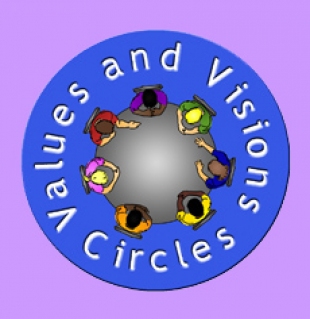The Circle Model
When we began thinking about soulmaking, we immediately decided to call them circles. It is the form most appropriate to our subject and our intention.
A circle is a whole made up of equally valuable parts. Some people in your group may have read more books or seen more films but this does not make them experts on the significance of these and other stories for your life. When you sit in a circle, you are part of a community of equals striving for depth and meaning.
In many times and cultures, the circle has been recognized as a sacred space. In an excellent book on the subject, The Ceremonial Circle by Sedonia Cahill and Joshua Halpern, Anethea Francine, a workshop leader and ceremonialist, talks about the significance of the form:
"When we sit in a circle it reminds us that the point of reference is the middle, and the middle is both empty and full of everything. Everyone is equidistant from the middle so there is no sense of hierarchy. The point of reference changes as different people speak. It is a different kind of focusing and a different type of awareness about relationship to one another and to the whole when we sit in a circle."
Just as the circle mirrors equality, it also speaks symbolically about how everything is connected. There is no beginning and no end. This is great understanding for a soulmaking group. It reinforces the idea that when we gather to make connections, we strengthen every part as well as the whole community. The work, like the shape of a circle, is ongoing. We are on a journey; it is the traveling itself that is important, not the destination.
Sedonia Cahill and Joshua Halpern have put forth beautifully some of the goals of a circle, ones which we would recommend to any Values & Visions Circle:
"When people are real in the circle we love them for their process of becoming whole. We love each other for being who we are, with all our perfections and imperfections. The essence of the process is to validate that we are living, breathing, dancing, real people, who feel pain and fear and make mistakes, while loving and caring about each other. The circle form creates a place for everyone to work, pray, be real, and feel at one with each other, all together.
"Being in a circle teaches us to respect ourselves and one another. When this happens we are brought into an experience of immanence and sacredness, making us better able to honor the beauty and integrity of the earth. If enough people gather in circle and grapple with their identities within this context, it enhances the possibilities for all of us".
Types of Circles
Before you start your Values & Visions Circle, you need to decide what kind of circle will be the most valuable and feasible. Some decisions, such as the membership selection system, the emphasis of your conversations, and the expected length of commitment, need to be made early in the planning. Other decisions, such as the particular films, books, or tapes you will use, can be made later once your circle has formed. The first decision to make is what type of circle you want and its size.
• Intimate Circles consist of two to seven people — perhaps spouses or close friends. The group is already bonded and members feel free to disclose their deepest feelings to each other. The key challenge for intimate circles is shifting the patterns of their habitual interactions, which may be recreation or socializing, to soulmaking.
• Intentional Circles consist of eight to twelve people who are drawn together by shared desires and purposes. They might be people who love movies or books and want to have serious conversations about them. They might be faith formation or covenant groups who have decided to go on a spiritual journey together. They could be a small study circle or neighborhood salon interested in spirituality.
Often these circles are by invitation only. The members make a commitment to each other and continue indefinitely. If one person leaves, another is invited to join. Other circles choose to meet for a specific period of time — say, six weeks or even one year — after which they decide to stop or to make a new commitment for another period.
A simple way to build a circle this size is for you to ask two friends to each suggest two other friends for a core group of seven. Get together, talk about your ideas for the circle, and then each recommend one more person to round out the circle. Since some of your invitees will not be able to attend, you should end up with a group of ten to twelve.
• Open Call Circles are open to anyone who is interested. Your publicity explains what the circle will do and mentions a meeting time and place. For these circles, the program itself may be the most important factor in attracting participants; they will come to talk about specific titles or a particular theme.
Even with open call circles, it may be a good idea to close the group after the first few sessions. Others interested could wait for the next new program. This emphasizes that the circle is not a drop-in activity, but a serious commitment by the participants.
In large circles it may be difficult for everyone to join in the conversation. You might consider breaking into smaller groups of no more than twelve people after a first planning session. One fun way to quickly divide a large group is to line everyone up by height and then send every other person to another room.
